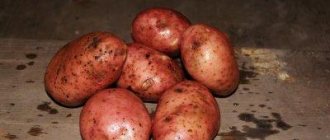Elizabeth potatoes are a table variety with an average ripening period. Attracts gardeners with a number of positive characteristics. It shows high productivity, is very resistant to pests and diseases, and has good taste. If favorable conditions are met, it can be stored until spring.
Elizaveta - an old potato variety of domestic selection
Description of Elizabeth variety potatoes with photo
The Elizabeth variety of potatoes belongs to the table varieties. It adapts perfectly to almost any climatic conditions, produces high yields, and is universal in use. Thanks to its strong immunity, the crop rarely gets sick, including late blight.
Bush
The bushes of this variety of vegetable crop are erect, compact, with a small number of shoots. The tops are medium in height. The foliage of the branches is good, the leaf plates are not small, medium-dissected, slightly wavy along the edges. There is slight pubescence on their surface, the veins are clearly expressed. The Elizabeth potato does not bloom profusely, the buds are small, white, and fall off quickly. After the end of the budding period, seed peas do not form in place of the inflorescences.
Thanks to the well-developed root system, Elizabeth potato tubers form together
Tubers
The tubers of the variety are uniform, their shape is oval-round, they are slightly flattened on the sides, and have a blunt tip in the upper part. The average weight of one tuber is 120 g. The skin of the potato is smooth, thin, beige in color, and there are a small amount of shallow eyes on the surface. The pulp is white, starch content up to 18%.
Harvest and storage
Timely harvesting and proper storage will increase the shelf life of potatoes and protect the tubers from spoilage.
How and when to collect
The harvest is harvested 80 days after planting. This is done in dry weather.
On the eve of digging up the tubers, the area is cleared of grass. The tops are not completely cut off, leaving a small part above the ground to determine the location of the tubers.
Storage features and keeping quality of the variety
The dug up tubers are dried and placed in boxes. The harvest is stored in a dry and dark room with a temperature no higher than +5⁰С. For storage on an uninsulated loggia, special insulated boxes are used.
Characteristics of potato variety Elizaveta
Tubers of the Elizabeth variety are characterized by good commercial qualities, have an excellent appearance and are ideal for sale. Potatoes can be transported over long distances. The harvest is not susceptible to rot, is stored well for several months after harvest, and if optimal conditions are created, it lasts until the next season.
Comment! The keeping quality of Elizabeth potatoes is 93%.
Taste qualities of potatoes Elizaveta
The tubers have good taste, without excessive wateriness and dryness. Their taste is balanced and pleasant. After cleaning, as well as during heat treatment, the pulp does not change its color. Elizabeth potatoes are used for various purposes: they are fried, boiled, stuffed, and stewed. Tubers are rich in amino acids, protein and vitamins.
Moderate calorie content allows the variety to be used for baby and dietary nutrition
Ripening time for potatoes Elizaveta
Elizabeth potatoes ripen approximately 2-2.5 months after planting, but this variety can be dug up for testing after 50 days. The final formation of tubers occurs on the 90th day.
Attention! The seed material does not need to be renewed, since the variety does not degenerate.
Productivity
When favorable conditions are created and quality care is provided, one potato bush Elizaveta produces up to ten large tubers. Judging by the reviews of farmers, the total yield of the variety is 30-40 tons per hectare. In particularly favorable conditions, the result can reach 50 tons.
Growing regions
Elizabeth potatoes are often grown on private farms; some farmers plant them for sale. Since the variety is undemanding to care, even inexperienced gardeners can cultivate it. It is recommended to grow this variety in the Central, Northern, Far Eastern, Volga-Vyatka, North Caucasus and Northwestern districts.
Comment! In the southern regions, the variety produces two harvests per season.
Disease resistance
Elizaveta has established itself as a disease-resistant variety. Potatoes are rarely affected by scab or cancer; the tops are practically not infected with blackleg. In addition, the variety has good immunity to fungal infections and rarely suffers from Alternaria, late blight, and fusarium. Cases of nematode attacks are isolated.
The main scourge for the plant is considered to be insects: wireworms, thrips, and Colorado potato beetles. The former are combated by digging up the soil and treating it with potassium permanganate, and the latter with insecticides. To get rid of the latter, use manual methods or chemicals.
Diseases and pests
The Queen Elizabeth potato variety is characterized by high immunity. But, despite this, it is sensitive to late blight and macrosporiosis. You can avoid such problems by treating the tubers and then the bushes with products that contain copper.
Colorado potato beetle on potatoes
As for pests, Colorado potato beetles, aphids, potato moths, and thrips can harm potatoes. Chemical insecticides will help deal with them.
Despite its ancient origin, Elizabeth potatoes are still considered one of the most common and sought-after varieties. This popularity is explained by its excellent taste, white flesh, low maintenance requirements and attractive presentation.
Advantages and disadvantages
Potatoes of the Elizabeth variety have practically no disadvantages. If you follow agricultural techniques and choose the right region for its cultivation, then there will be nothing to complain about.
Elizaveta produces a minimal amount of non-marketable and small tubers
Advantages:
- productivity;
- unpretentiousness;
- high commercial qualities;
- taste characteristics;
- keeping quality;
- transportability;
- strong immunity;
- non-degeneracy.
Flaws:
- sensitivity to frost;
- a reflection of unfavorable growing conditions on the crop.
History of variety breeding
The Elizaveta variety is a long-standing representative of Russian selection, bred by scientists of the Leningrad Scientific Research Institute together with employees of the Volzhsk Breeding Station. The biological basis of this seven-species hybrid was S.vernei, S.phureja, S.acaule, S.demissum, S. stoloniferum, S.andigenum and the variety S.tuberosum. In 1996, potatoes were included in the state register of Russia as a mid-early table vegetable, recommended for cultivation in the Northern, Central, Western regions, the North Caucasus and Far Eastern regions of the state.
Did you know? Lebanese farmer Khalil Semhat managed to grow the largest vegetable tuber. The weight of the root crop was 11.2 kg.
Landing rules
If you adhere to the rules of agricultural technology, then the Elizabeth potato will show all its advantages to the maximum. The first thing gardeners do for this is to prepare a site for planting crops in the fall. To do this, choose a well-lit place with loose, non-clayey soil and deep groundwater; it is desirable that buckwheat, cabbage or legumes grow on it this season. Next, the area is dug up and fertilized with organic and mineral compounds containing nitrogen compounds.
Advice! It is best to change the planting location of the crop annually.
With the arrival of spring, a couple of weeks before the expected planting date for Elizabeth potatoes, they begin to germinate them. Why planting material is laid out in a well-lit place and sprinkled with water every three days. After about 10-12 days, when the sprouts on the tubers have grown to 4 cm in length, they will be ready for planting.
Work usually starts in early May, but in particularly hot regions this deadline can be moved to mid-April. The main thing is that by this time the soil has already warmed up to +10 °C, and the air to +15 °C.
When planting crops, proceed according to the following scheme:
- tubers are treated with humates, potassium permanganate or growth stimulants;
- dig holes in the soil to a depth of half a shovel at a distance of 30 cm;
- One potato is placed in each and buried.
Typically, potato consumption when planting is 25 kg per hectare of land
Growing
The characteristics of the Lileya variety indicate that it is a fairly high-yielding crop. However, the quality and quantity of fruits are influenced by the nuances involved in growing the plant. Thus, according to the recommendations of fruit and vegetable growers, potatoes should not be planted in the place where nightshade crops grew before. The best predecessors for the variety will be:
- cucumbers;
- annual herbs;
- legumes;
- cabbage crops.
In this case, the soil should be fertile, loose and light. You can improve the quality of the soil in the fall by plowing the soil to a depth of 30 cm and adding humus with complex fertilizers.
Pre-sprouted potatoes are planted. The best time for this will be the end of April or the beginning of May, when the soil warms up to 10 degrees. Planting pattern: 35 cm between bushes and 80 cm between rows.
Care instructions
Caring for Elizabeth potatoes is easy. If you follow all the standard rules of agricultural technology, then there will be no problems with the plant. Since the variety is moisture-loving, it is irrigated regularly, but in moderation. The first time watering is carried out at planting, the second time - when the sprouts become about 10 cm long, then they are guided by the weather. On hot days, irrigation is carried out once a week.
Comment! After flowering, potato moisture is kept to a minimum to avoid late blight infection.
Plantings are weeded regularly. Hilling is carried out three times per season: at the stage of bush height 8 cm, two weeks later, at a size of 25 cm. Particularly careful gardeners mulch the rows with mown grass or straw.
During the growing season, it is advisable to feed Elizabeth potatoes. The procedure is performed at the root two or three times. Typically, organic or mineral compounds are used for this: mullein, bird droppings. A couple of weeks before harvesting the tubers, it is useful to fertilize the beds with superphosphate.
Advice! A week before harvesting potatoes, gardeners recommend mowing the tops to prevent the spread of late blight and to make the tuber skins coarser.
During hilling, the ridge is formed as high and wide as possible
How to properly care for the variety
After planting, you need to provide the potatoes with watering, fertilizing, loosening and hilling. Also, to get a good harvest, the plant must be protected from insects and pests.
Features of watering
Queen Elizabeth is classified as a moisture-loving variety, so the crop must be watered at least three times per season. The first time watering is carried out when the sprouts reach a height of about 20 cm, the second time during flowering and the third time after flowering has completed.
Important! Watering must be stopped 14 days before harvest.
Feeding and fertilizing
It is recommended to combine fertilizing with watering. Fertilizers should be applied after watering the plants.
Hilling and weeding
After each watering or rain, it is recommended to loosen the soil and also remove any weeds that have appeared. The crop should be hilled three times a season. The first time, as soon as the tops grow to 20 cm in height, the second time after 14 days and the third time three weeks after the second hilling.
Basic rules for caring for Elizabeth
Caring for Elizabeth, like any other potato variety, is quite simple. It is necessary to follow standard measures, and then no problems will arise.
Soil irrigation
Elizabeth needs to be watered. This is a water-loving variety. But at the same time, we remember that excess water causes no less harm than its absence. The crop must be watered according to a certain pattern. The standard is:
- The first irrigation is carried out immediately after the green part of the crop has risen 10-15 cm above the ground level.
- The second time the potatoes are watered immediately after the inflorescences appear.
- The third time was when the inflorescences disappeared.
Further watering is not recommended. The reason for this is simple. After potato flowering, a period of high late blight activity begins. And this disease can destroy up to 50% of the crop in a short time.
Fertilizer
As noted above, it is imperative to fertilize the soil, especially in the fall. Potatoes are not a crop that needs fertilizer during its growing season. Yes, fertilizing will not hurt, but still, if the soil is well fertilized in the fall, then there is no need to add additional nutrients. This is especially true for nitrogen-containing substances. It is forbidden to use them in the active phase of tuber development. Nitrogen stimulates the growth of tops, thereby slowing down the ripening and development of tubers.
Weeding and hilling
Hilling is perhaps the main agrotechnical procedure, which significantly affects crop yield. If the bushes are not hilled, then additional stolons will not form, and they, in turn, increase the yield by 20-30%. Potatoes need to be hilled 2 times per season. The first time, when the tops grew to 15 cm, the second - to 25.
In addition to helping to form additional stolons, hilling also loosens the soil and removes weeds from the site.
If after hilling the weeds continue to grow and oppress the crop, then additional weeding is carried out, clearing the area of weeds. If there are no weeds, then weeding is an optional measure.
Mowing the tops
This procedure is not necessary, but many experienced gardeners recommend carrying it out a week before harvest. There are two reasons for mowing tops:
- Firstly, this is how gardeners protect crops from the development of late blight of tops, a fungus that reproduces by spores.
- Secondly, after removing the green part, all the force is directed to the formation and ripening of tubers.
Basic rules for caring for Elizabeth
Caring for Elizabeth, like any other potato variety, is quite simple. It is necessary to follow standard measures, and then no problems will arise.
Soil irrigation
Elizabeth needs to be watered. This is a water-loving variety. But at the same time, we remember that excess water causes no less harm than its absence. The crop must be watered according to a certain pattern. The standard is:
- The first irrigation is carried out immediately after the green part of the crop has risen 10-15 cm above the ground level.
- The second time the potatoes are watered immediately after the inflorescences appear.
- The third time was when the inflorescences disappeared.
Further watering is not recommended. The reason for this is simple. After potato flowering, a period of high late blight activity begins. And this disease can destroy up to 50% of the crop in a short time.
Fertilizer
As noted above, it is imperative to fertilize the soil, especially in the fall. Potatoes are not a crop that needs fertilizer during its growing season. Yes, fertilizing will not hurt, but still, if the soil is well fertilized in the fall, then there is no need to add additional nutrients. This is especially true for nitrogen-containing substances. It is forbidden to use them in the active phase of tuber development. Nitrogen stimulates the growth of tops, thereby slowing down the ripening and development of tubers.
Weeding and hilling
Hilling is perhaps the main agrotechnical procedure, which significantly affects crop yield. If the bushes are not hilled, then additional stolons will not form, and they, in turn, increase the yield by 20-30%. Potatoes need to be hilled 2 times per season. The first time, when the tops grew to 15 cm, the second - to 25.
In addition to helping to form additional stolons, hilling also loosens the soil and removes weeds from the site.
If after hilling the weeds continue to grow and oppress the crop, then additional weeding is carried out, clearing the area of weeds. If there are no weeds, then weeding is an optional measure.
Mowing the tops
This procedure is not necessary, but many experienced gardeners recommend carrying it out a week before harvest. There are two reasons for mowing tops:
- Firstly, this is how gardeners protect crops from the development of late blight of tops, a fungus that reproduces by spores.
- Secondly, after removing the green part, all the force is directed to the formation and ripening of tubers.
Elizabeth's immunity
The Elizabeth variety has a fairly strong immunity that protects against such misfortunes as:
But at the same time, Elizabeth is not protected from fusarium, alternaria and late blight of tubers.
Alexandra Vladimirovna, Kyiv, 49 years old.
Growing up with Elizabeth left a double impression. On the one hand, the variety is quite good, easy to care for, the harvest is decent, and the tubers are large in size. But for some reason we have 1/6 of the harvest with voids. The tubers are large, but empty inside. Maybe some kind of disease, I don’t know, but this has never happened before with other varieties. They didn’t bother to figure it out, they simply abandoned Elizabeth.
Dmitry Vladimirovich, Voronezh, 54 years old.
We have been raising Elizabeth for quite some time. The variety is good. The tubers are not overcooked and have a sweetish taste. Potatoes do not degenerate, the harvest is stable and always good. The tubers are stored well and do not spoil.
Oleg Vladimirovich, Rostov, 51 years old.
Elizabeth likes it. Not the main variety that we grow, but we always allocate 2-3 rows for Elizabeth. Easy to care for, loves watering. We take good care: we mow the tops before harvesting, water, fertilize, and hill up. There are never any weeds in the garden. We haven’t encountered diseases for 10 years; we’ve learned to protect potatoes from them. Elizabeth's yield is good, the tubers are large. The taste is normal. Of course, it’s far from ideal, but the taste is quite good.
Peculiarities
Meteor potatoes: variety description, photos, reviews
Due to his age, Lorch has taken root well not only in most regions of the Russian Federation, but also in all neighboring countries. And its taste and beautiful appearance of the fruit have ensured it more than one decade of successful sales in many European markets. In addition, do not forget that it is also used for industrial purposes to produce starch.
IMPORTANT! As for choosing an area for planting, it is necessary to highlight the following: young crops of this potato crop do not like too much heat and lack of moisture in the soil. Therefore, gardeners from the southern regions should prepare good watering conditions, preferably automated. with a lack of potassium and phosphorus in the soil
Plant your sprouted tubers in holes about 8 cm deep.
with a lack of potassium and phosphorus in the soil. Plant your sprouted tubers in holes about 8 cm deep.
Unlike many other types of potatoes, Lorch tubers should be placed sprouts down. This stimulates the formation of more spreading bushes, which, accordingly, will have better lighting. Subsequently, your plants need to be provided with mandatory fertilizing; nitrogen fertilizers are best suited here, which can be applied already at the growing season
Your sprouted tubers should be planted in holes about 8 cm deep. Unlike many other types of potatoes, Lorch tubers should be placed with the sprouts facing down. This stimulates the formation of more spreading bushes, which, accordingly, will have better lighting. Subsequently, your plants need to be provided with mandatory fertilizing; nitrogen fertilizers are best suited here, which can be applied already at the growing season.
Read more about how to feed potatoes, what fertilizers are the best and why experts recommend the use of mineral fertilizers. And also when and how to fertilize, how to do it correctly when planting.
In general, standard agrotechnical techniques are used when growing this variety - hilling, weed control, mulching if necessary and desired, watering.
Agricultural technology
Soil preparation
The best soils for potatoes are sandy and loamy soils.
It is advisable to dig up the soil for Elizabeth potatoes twice: in the fall and in the spring. At the same time, fertilizer is applied. The most suitable organic fertilizers are well-rotted manure and aged compost. On loams, fertilizers are applied in the fall, and on sandstones - in the spring. For previously fertilized soils, 1 bucket of fertilizer per 1 m2 is sufficient. For poor areas, the dose of fertilizer is doubled. The best mineral fertilizer is the ash of deciduous trees. It is enough to add 50-60 g per 1 m2. A local method of applying fertilizers is also used (directly into the hole during planting).
Preparation of planting material
It is better to select planting tubers in the fall. You need to take potatoes for planting from the best bushes, selecting healthy and undamaged root crops, the size of a chicken egg.
In the fall, it is advisable to green up the planting material: hold the vegetables in the light until they turn green (such potatoes are safe to store, and rodents are indifferent to them).
In the spring, 2-4 weeks before planting, potatoes should be placed in a warm (12-15 degrees) and bright place for germination. Elevated temperatures will lead to premature growth of shoots, wilting and depletion of tubers. You can sprout potatoes in boxes, in perforated (with cut-out ventilation holes) plastic bags, or simply in bulk on the floor. Before planting, potatoes are treated for pests and diseases.
Landing
Potatoes are planted when the ground warms up to 8-10 degrees. You can determine the moisture content suitable for planting in a simple way: the soil should not stick to the shovel and crumble when squeezed in your hand. The planting method depends on the structure and condition of the soil. If the soil is light and the climate is hot and dry, then planting is required under a shovel in holes or furrows. In heavy and wet soils, planting is carried out using the method of cutting ridges, raising the planting material above the soil level.
Potatoes Elizabeth - productive potatoes
Potatoes are planted according to the scheme - 35 by 70 cm. The planting depth is different for different soils. The heavier the soil, the shallower the depth of planting of tubers. On clay soils, potatoes are deepened by 4-5 cm; on sandy and sandy loam (light and loose) soils, planting is carried out at a depth of 10-12 cm.
Weeding and loosening
Weeding and loosening of the soil must be carried out systematically. Removing weeds and breaking up the surface soil crust (for oxygen access) improves plant growth.
Hilling
The first hilling of potatoes is carried out when the sprouts reach 8 cm in height, and the next one - two weeks after the first (the sprouts will already be 20-25 cm tall). The minimum number of hillings is 2 times. A high and wide ridge is formed.
Watering
Watering potatoes
The Elizabeth varietal potato has increased watering requirements. Both excess and lack of moisture are unacceptable. You need to water on time and efficiently. The first watering is carried out immediately after planting. The second - after the first weeding. Then it depends on the weather. In persistent heat, water every 5 days. At moderate temperatures - after 10 days. For this variety, drip irrigation is advisable - it will protect the harvest in dry summers.
Top dressing
When green shoots appear, the first fertilizing is carried out - it should be organic. Manure or bird droppings will do. To avoid burns to plants, fertilizers are dissolved in water (in proportions of 1:15) and left for 2 days. This solution is added to the plants at the root on moist soil. Each bush requires 0.5-1 liter of fertilizer. The second feeding is appropriate during flowering. You can add a mixture of ash (4 tbsp) and 1.5 tsp per 1 linear meter. sulfate or just sprinkle 1.5 tbsp. l. superphosphate.
Diseases and pests
Elizabeth's high immunity allows her to avoid diseases such as cancer, golden cyst nematode, scab, but she is sensitive to macrosporiosis and late blight (with excess moisture). It is recommended to pickle the tubers before planting or treat the bushes with copper-containing preparations.
Colorado beetle
Chemical insecticides, which can be purchased at specialized retail outlets, will help in the fight against pests such as the Colorado potato beetle, aphids, thrips, and potato moth. To escape from mole crickets and wireworms, disinfection of the soil with solutions or periodic crop rotation will help.
How to plant potatoes on a plot
Potatoes must be planted in the right place and prepared in time. Seed material is prepared in advance, and planting is carried out according to a certain algorithm.
Selecting and preparing a seat
Potato plantings are prepared in the fall. The soil is dug up, all roots, weeds and stones are removed. Apply organic fertilizers:
In the spring, digging is repeated and mineral fertilizers containing nitrogen, phosphorus, potassium, and manganese are applied. Choose a well-lit place and observe crop rotation. It is recommended to choose soil that is loose and easy to grow. If this is not possible, then drainage material is laid during planting.
What culture “loves”
Potato Elizabeth is an unpretentious variety to care for, but it has its own preferences in climate, soil and humidity.
Suitable climate
Elizabeth potatoes grow and develop well in any climatic conditions. It was bred for cultivation in northern regions. However, it produces high yields in temperate and southern regions.
Illumination, humidity and temperature conditions
Potatoes prefer well-lit areas, without drafts, with humidified air. Favorable air temperature for growth is 20 – 24 °C. Elizabeth is a moisture-loving variety; it needs to be provided with sufficient watering.
Required soil composition
Potatoes prefer light, loose soil with a drainage layer. Sandy and sandy loam soils are suitable; when growing in clay and loamy soils, it is recommended to add sand to the soil.
How to fight the Colorado potato beetle using folk remedies: mustard and vinegar
Read
If the soil is highly acidic, it is necessary to add lime in the fall or spring in the form of fluff limestone, dolomite flour or chalk. Each type of soil has its own application rate; it is indicated on the packaging of the composition.
Favorable and Undesirable Neighbors
It is recommended to plant next to potato beds:
- Mustard. It repels the Colorado potato beetle.
- Oats. It enriches the soil with nitrogen.
- Pumpkin and zucchini. They enrich the soil with nitrogen and cleanse it.
- Cucumbers. Do not affect potato growth.
Unfavorable crops for potatoes are members of the nightshade family and vegetables that form root crops.
These include:
- tomatoes;
- beet;
- carrot;
- Jerusalem artichoke.











